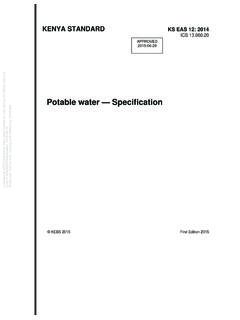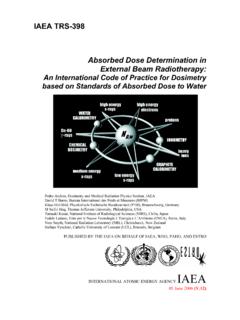Transcription of Yield gap analysis of field crops - Home | Food and ...
1 41. Yield gap analysis of field crops Methods and case studies Cover photograph: FAO/Daniel Hayduk FAO information products are available on the FAO. website ( ) and can be purchased through Yield gap analysis FAO. water . REPORTS. of field crops : 41. Methods and case studies VO Sadras South Australian Research & Development Institute, Australia KG Cassman and P Grassini University of Nebraska, USA. AJ Hall IFEVA, University of Buenos Aires, Argentina WGM Bastiaanssen Delft University of Technology, The Netherlands AG Laborte International Rice Research Institute, The Philippines AE Milne Rothamsted Research, UK.
2 G Sileshi World Agroforestry Centre, Malawi P Steduto FAO, Italy FOOD AND AGRICULTURE ORGANIZATION OF THE UNITED NATIONS. Rome, 2015. The designations employed and the presentation of material in this information product do not imply the expression of any opinion whatsoever on the part of the Food and Agricultural Organization of the United Nations (FAO), or of the water for Food Robert B. Daugherty Institute concerning the legal or development status of any country, territory, city or area or of its authorities, or concerning the delimitation of its fron- tiers or boundaries.
3 The mention of specific companies or products of manufacturers, whether or not, these have been patented, does not imply that these have been endorsed or recommended by FAO, or DWFI in preference to others of a similar nature that are not mentioned. The views expressed in this information product are those of the authors and do not necessarily reflect the views or policies of FAO, or DWFI. ISBN 978-92-5-108813-5 (FAO). Recommended citation: FAO and DWFI. 2015. Yield gap analysis of field crops Methods and case studies, by Sadras, , Cassman, , Grassini, P., Hall, , Bastiaanssen, , Laborte, , Milne, , Sileshi , G.
4 , Steduto, P. FAO water Reports No. 41, Rome, Italy. FAO and DWFI encourage the use, reproduction and dissemination of material in this information product. Except where otherwise indicated, material may be copied, downloaded and printed for private study, research and teaching purposes, or for use in non-commercial products or services, provided that appropri- ate acknowledgment of FAO and DWFI as the source and copyright holder is given and that FAO's and DWFI's endorsement of users' views, products or services is not implied in any way. All requests for translation and adaptation rights and for resale and other commercial use rights should be made via or addressed to FAO information products are available on the FAO website ( ) and can be purchased through FAO and DWFI, 2015.
5 Iii Contents List of figures v List of boxes viii List of tables viii Foreword ix Acknowledgements x Preface xi Summary xii 1. Introduction 1. 2. Definitions of crop Yield 4. Evolution of Yield criteria 4. Yield definitions 5. 3. Scales, data sources and overview of methods 10. Actual Yield data: spatial scales and accuracy 10. Temporal scales 15. Removing the dynamic components of environment and technology 15. Capturing the dynamic components of environment and technology 15. Modelled Yield 18. Desirable attributes of models in Yield gap studies 18. Weather data for modelling crop Yield 19.
6 Modelling Yield within the context of a cropping system 22. 4. Approaches to benchmark Yield and quantify Yield gaps 23. Approach 1: high-yielding fields, experimental stations and 23 growers contests Sunflower in rainfed systems of Argentina 23. iv Maize in sub-Saharan Africa 24. Grain legumes in India 26. Wheat-maize double crop in the Hebei plain of China 26. Approach 2: boundary functions accounting for resources 27. and constraints Yield and water productivity gaps 27. Wheat in rainfed systems 27. Millet in low-input systems of Africa 31. Sunflower in rainfed systems of Argentina 32.
7 Maize in irrigated systems of USA 33. Yield vs water availability in a critical period of Yield determination 34. Yield gaps and nitrogen uptake 35. Yield gaps and soil constraints 36. water productivity as a function of Yield 37. Approach 3: modelling 38. Maize (USA, Kenya) and wheat (Australia) 38. Rice in Southeast Asia 41. Maize in Zimbabwe 42. Quinoa in Bolivia 42. Estimating Yield potential with climate indices 42. FAO's Agro-Ecological Zones system 44. Approach 4: remote sensing 44. Benchmarking crop Yield and Yield gaps with remote sensing 46. Benchmarking water productivity with remote sensing 46.
8 5. Conclusions and recommendations 48. Glossary 50. v List of figures 1. Time trends in FAO's Net Production Index (2004-2006 = 100) 2 2. Decreasing rate of improvement of soybean Yield in Kentucky (USA) with 5. increasing cropping intensity, Measured 3. Definitions of Yield relevant to Yield gap analysis ; arrows illustrate some 5. Yield gaps 4. County-level average (2004-2008) yields for rainfed and irrigated maize in 11. Nebraska and Kansas 5. Sub-national (district, region, province) data coverage in Sub-Saharan 11. Africa 6. Comparison between average farmer-reported Natural Resource District 12.
9 (NRD) in Nebraska, USA, and USDA-NASS county-level average maize and soybean yields (upper and bottom panels, respectively) 7. Box-plots of farmer-reported maize Yield , applied irrigation, and N fertiliser 13. during the 2004-2011 interval in the Lower Platte North Natural Resource District in Nebraska (USA) for irrigated (I) and rainfed (R) maize 8. Dynamics of nitrogen fertilisation in France according to three sources: 14. AGRESTE (Statistical Service of the French Ministry of Agriculture), ONIGC. (French National Office of Arable crops ), and ARVALIS (French Technical Institute for Cereal crops ) 9.
10 Dynamics of rizhoctonia root rot in direct-drilled wheat crops in South 14. Australia. Wheat was grown in rotation with volunteer pasture (closed square), pea (closed circle), medicago (open circle) or in monoculture (open square). Error bars are lowest significant difference (P= ). 10. Trends in grain yields of (a) irrigated and rainfed maize in Nebraska, (b) 16. wheat in The Netherlands and wheat in Wimmera (South-east Australia). Sequential average yields in (c) Nebraska, (d) The Netherlands and Wimmera, and associated coefficients of variation for (e) Nebraska, and (f).











